Analyzing Relationship Between Hotel Pricing, Occupancy, Satisfaction
VerifiedAdded on 2021/01/02
|7
|2113
|461
Report
AI Summary
This report delves into the intricate relationship between hotel pricing, occupancy rates, and guest satisfaction within the hospitality industry, using the Hilton Hotel chain as a case study. It explores how different pricing models, such as cost-based and customer-based strategies, impact customer expectations and, consequently, satisfaction levels. The report highlights that high occupancy rates can indicate quality service but also presents challenges like potential service delays and management issues. It also examines how customer perception, influenced by factors like room rates and online reviews, plays a crucial role in shaping overall satisfaction. The analysis covers the strategic importance of understanding customer needs, managing service quality, and adapting pricing strategies to optimize both revenue and customer loyalty. The report concludes that while hotel pricing significantly influences customer satisfaction, occupancy rates indirectly affect it, emphasizing the importance of balancing service quality and operational efficiency.
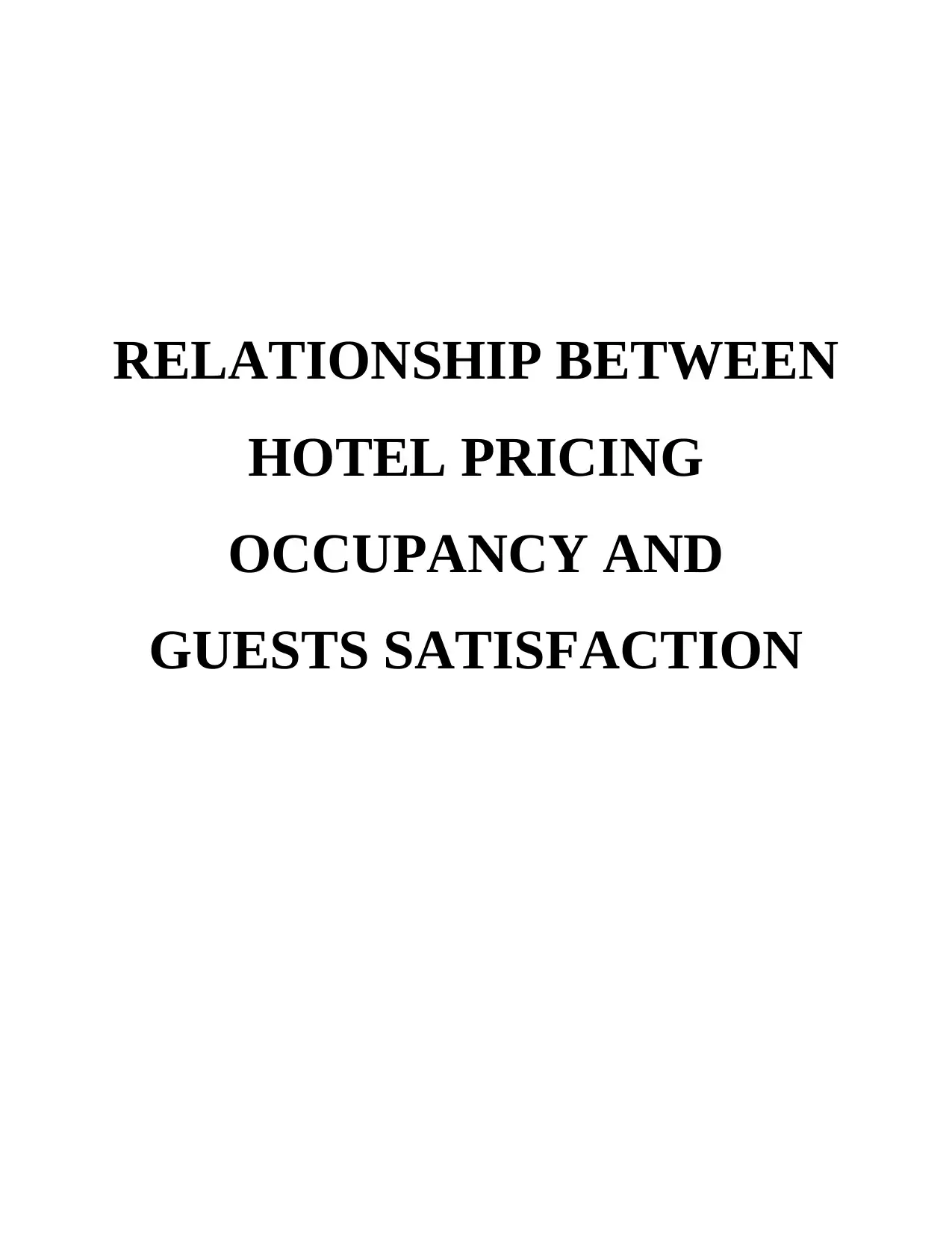
RELATIONSHIP BETWEEN
HOTEL PRICING
OCCUPANCY AND
GUESTS SATISFACTION
HOTEL PRICING
OCCUPANCY AND
GUESTS SATISFACTION
Paraphrase This Document
Need a fresh take? Get an instant paraphrase of this document with our AI Paraphraser
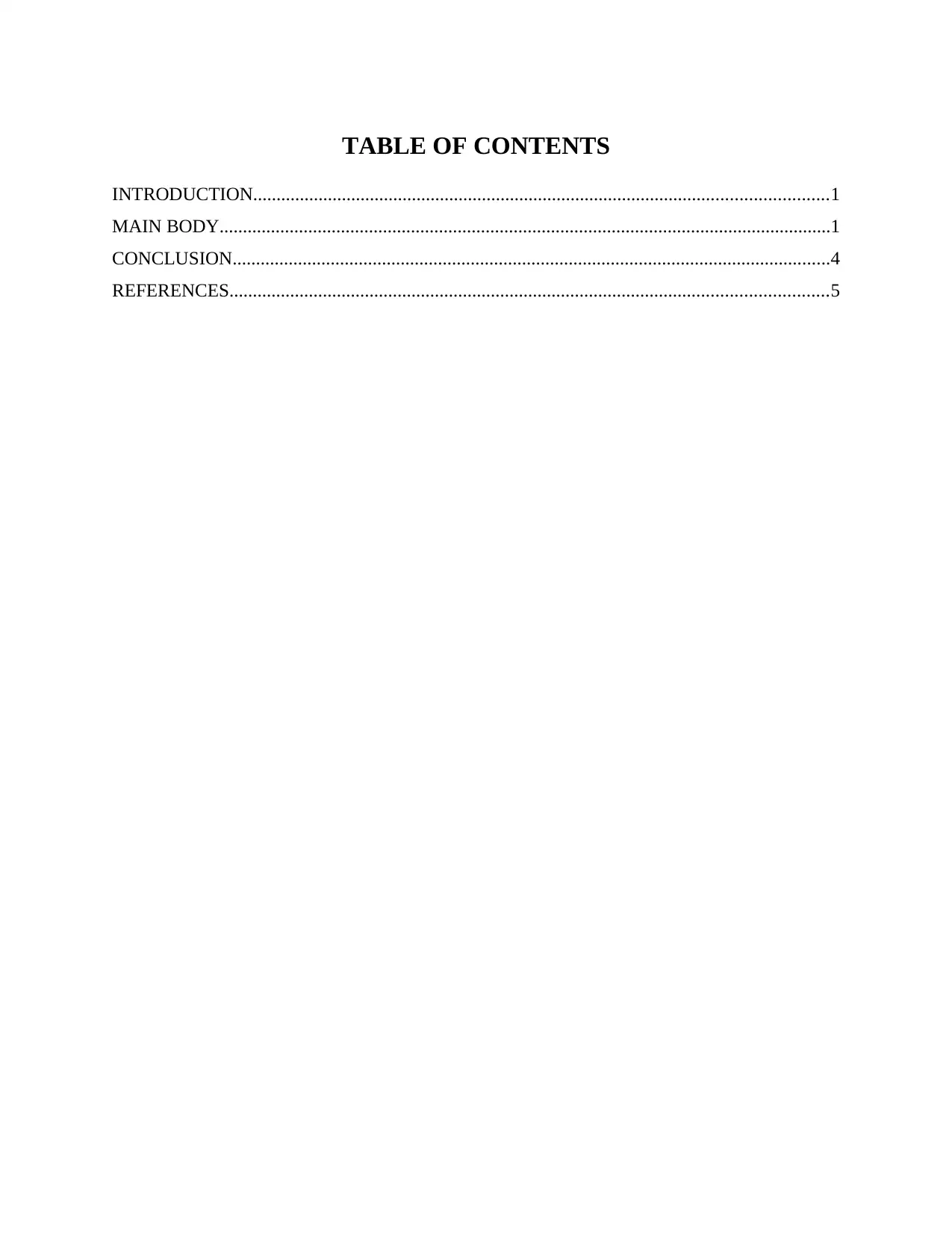
TABLE OF CONTENTS
INTRODUCTION...........................................................................................................................1
MAIN BODY...................................................................................................................................1
CONCLUSION................................................................................................................................4
REFERENCES................................................................................................................................5
INTRODUCTION...........................................................................................................................1
MAIN BODY...................................................................................................................................1
CONCLUSION................................................................................................................................4
REFERENCES................................................................................................................................5
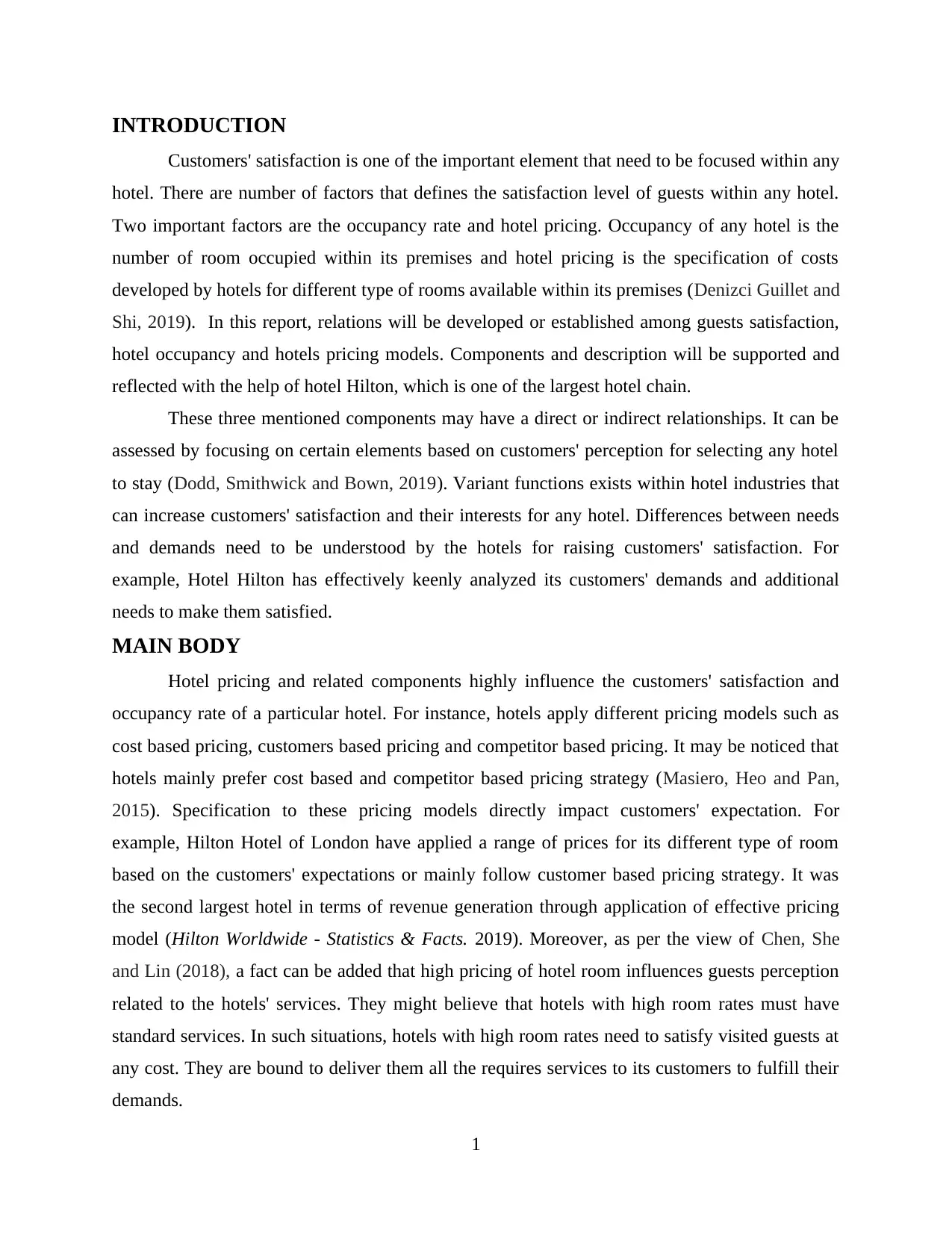
INTRODUCTION
Customers' satisfaction is one of the important element that need to be focused within any
hotel. There are number of factors that defines the satisfaction level of guests within any hotel.
Two important factors are the occupancy rate and hotel pricing. Occupancy of any hotel is the
number of room occupied within its premises and hotel pricing is the specification of costs
developed by hotels for different type of rooms available within its premises (Denizci Guillet and
Shi, 2019). In this report, relations will be developed or established among guests satisfaction,
hotel occupancy and hotels pricing models. Components and description will be supported and
reflected with the help of hotel Hilton, which is one of the largest hotel chain.
These three mentioned components may have a direct or indirect relationships. It can be
assessed by focusing on certain elements based on customers' perception for selecting any hotel
to stay (Dodd, Smithwick and Bown, 2019). Variant functions exists within hotel industries that
can increase customers' satisfaction and their interests for any hotel. Differences between needs
and demands need to be understood by the hotels for raising customers' satisfaction. For
example, Hotel Hilton has effectively keenly analyzed its customers' demands and additional
needs to make them satisfied.
MAIN BODY
Hotel pricing and related components highly influence the customers' satisfaction and
occupancy rate of a particular hotel. For instance, hotels apply different pricing models such as
cost based pricing, customers based pricing and competitor based pricing. It may be noticed that
hotels mainly prefer cost based and competitor based pricing strategy (Masiero, Heo and Pan,
2015). Specification to these pricing models directly impact customers' expectation. For
example, Hilton Hotel of London have applied a range of prices for its different type of room
based on the customers' expectations or mainly follow customer based pricing strategy. It was
the second largest hotel in terms of revenue generation through application of effective pricing
model (Hilton Worldwide - Statistics & Facts. 2019). Moreover, as per the view of Chen, She
and Lin (2018), a fact can be added that high pricing of hotel room influences guests perception
related to the hotels' services. They might believe that hotels with high room rates must have
standard services. In such situations, hotels with high room rates need to satisfy visited guests at
any cost. They are bound to deliver them all the requires services to its customers to fulfill their
demands.
1
Customers' satisfaction is one of the important element that need to be focused within any
hotel. There are number of factors that defines the satisfaction level of guests within any hotel.
Two important factors are the occupancy rate and hotel pricing. Occupancy of any hotel is the
number of room occupied within its premises and hotel pricing is the specification of costs
developed by hotels for different type of rooms available within its premises (Denizci Guillet and
Shi, 2019). In this report, relations will be developed or established among guests satisfaction,
hotel occupancy and hotels pricing models. Components and description will be supported and
reflected with the help of hotel Hilton, which is one of the largest hotel chain.
These three mentioned components may have a direct or indirect relationships. It can be
assessed by focusing on certain elements based on customers' perception for selecting any hotel
to stay (Dodd, Smithwick and Bown, 2019). Variant functions exists within hotel industries that
can increase customers' satisfaction and their interests for any hotel. Differences between needs
and demands need to be understood by the hotels for raising customers' satisfaction. For
example, Hotel Hilton has effectively keenly analyzed its customers' demands and additional
needs to make them satisfied.
MAIN BODY
Hotel pricing and related components highly influence the customers' satisfaction and
occupancy rate of a particular hotel. For instance, hotels apply different pricing models such as
cost based pricing, customers based pricing and competitor based pricing. It may be noticed that
hotels mainly prefer cost based and competitor based pricing strategy (Masiero, Heo and Pan,
2015). Specification to these pricing models directly impact customers' expectation. For
example, Hilton Hotel of London have applied a range of prices for its different type of room
based on the customers' expectations or mainly follow customer based pricing strategy. It was
the second largest hotel in terms of revenue generation through application of effective pricing
model (Hilton Worldwide - Statistics & Facts. 2019). Moreover, as per the view of Chen, She
and Lin (2018), a fact can be added that high pricing of hotel room influences guests perception
related to the hotels' services. They might believe that hotels with high room rates must have
standard services. In such situations, hotels with high room rates need to satisfy visited guests at
any cost. They are bound to deliver them all the requires services to its customers to fulfill their
demands.
1
⊘ This is a preview!⊘
Do you want full access?
Subscribe today to unlock all pages.

Trusted by 1+ million students worldwide
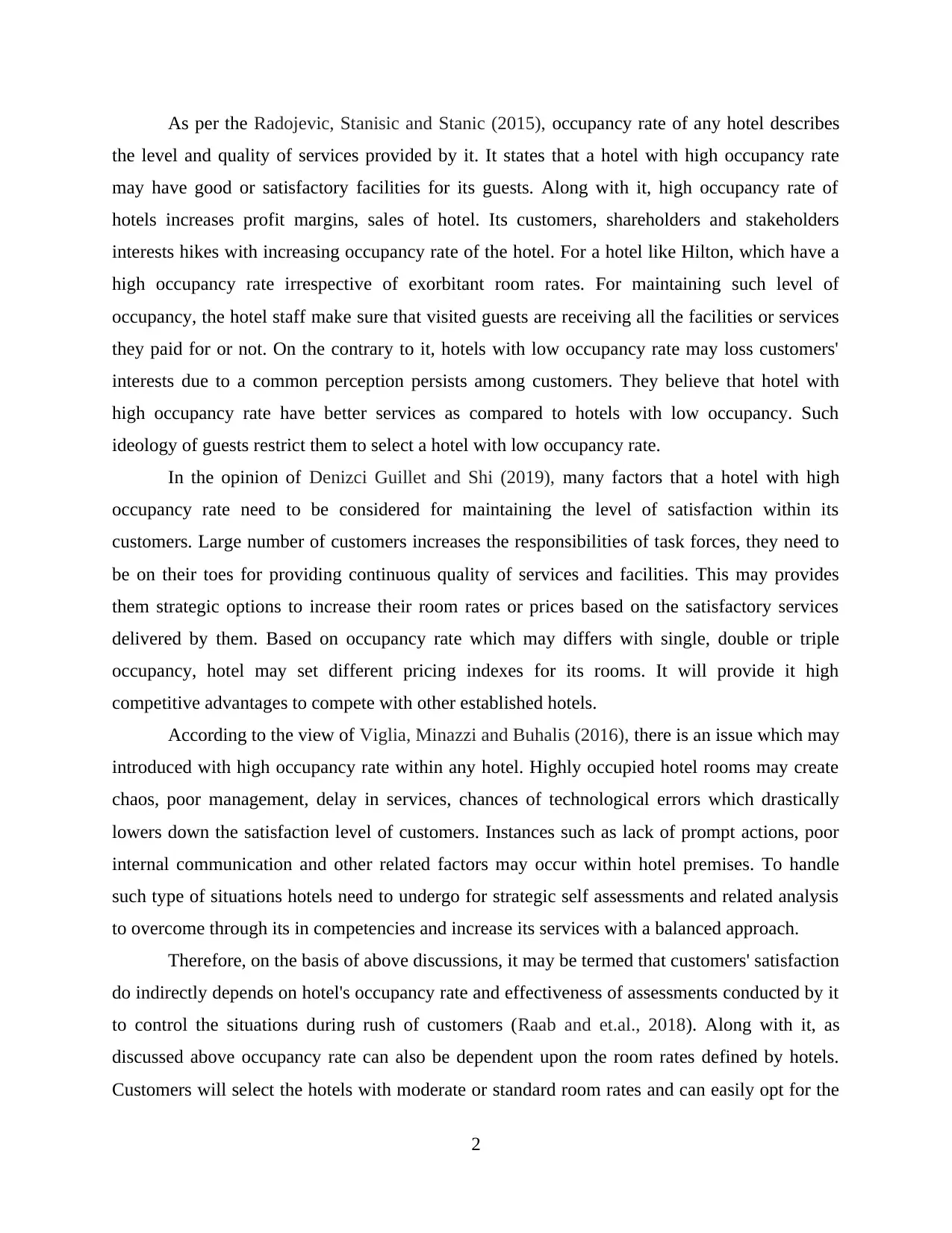
As per the Radojevic, Stanisic and Stanic (2015), occupancy rate of any hotel describes
the level and quality of services provided by it. It states that a hotel with high occupancy rate
may have good or satisfactory facilities for its guests. Along with it, high occupancy rate of
hotels increases profit margins, sales of hotel. Its customers, shareholders and stakeholders
interests hikes with increasing occupancy rate of the hotel. For a hotel like Hilton, which have a
high occupancy rate irrespective of exorbitant room rates. For maintaining such level of
occupancy, the hotel staff make sure that visited guests are receiving all the facilities or services
they paid for or not. On the contrary to it, hotels with low occupancy rate may loss customers'
interests due to a common perception persists among customers. They believe that hotel with
high occupancy rate have better services as compared to hotels with low occupancy. Such
ideology of guests restrict them to select a hotel with low occupancy rate.
In the opinion of Denizci Guillet and Shi (2019), many factors that a hotel with high
occupancy rate need to be considered for maintaining the level of satisfaction within its
customers. Large number of customers increases the responsibilities of task forces, they need to
be on their toes for providing continuous quality of services and facilities. This may provides
them strategic options to increase their room rates or prices based on the satisfactory services
delivered by them. Based on occupancy rate which may differs with single, double or triple
occupancy, hotel may set different pricing indexes for its rooms. It will provide it high
competitive advantages to compete with other established hotels.
According to the view of Viglia, Minazzi and Buhalis (2016), there is an issue which may
introduced with high occupancy rate within any hotel. Highly occupied hotel rooms may create
chaos, poor management, delay in services, chances of technological errors which drastically
lowers down the satisfaction level of customers. Instances such as lack of prompt actions, poor
internal communication and other related factors may occur within hotel premises. To handle
such type of situations hotels need to undergo for strategic self assessments and related analysis
to overcome through its in competencies and increase its services with a balanced approach.
Therefore, on the basis of above discussions, it may be termed that customers' satisfaction
do indirectly depends on hotel's occupancy rate and effectiveness of assessments conducted by it
to control the situations during rush of customers (Raab and et.al., 2018). Along with it, as
discussed above occupancy rate can also be dependent upon the room rates defined by hotels.
Customers will select the hotels with moderate or standard room rates and can easily opt for the
2
the level and quality of services provided by it. It states that a hotel with high occupancy rate
may have good or satisfactory facilities for its guests. Along with it, high occupancy rate of
hotels increases profit margins, sales of hotel. Its customers, shareholders and stakeholders
interests hikes with increasing occupancy rate of the hotel. For a hotel like Hilton, which have a
high occupancy rate irrespective of exorbitant room rates. For maintaining such level of
occupancy, the hotel staff make sure that visited guests are receiving all the facilities or services
they paid for or not. On the contrary to it, hotels with low occupancy rate may loss customers'
interests due to a common perception persists among customers. They believe that hotel with
high occupancy rate have better services as compared to hotels with low occupancy. Such
ideology of guests restrict them to select a hotel with low occupancy rate.
In the opinion of Denizci Guillet and Shi (2019), many factors that a hotel with high
occupancy rate need to be considered for maintaining the level of satisfaction within its
customers. Large number of customers increases the responsibilities of task forces, they need to
be on their toes for providing continuous quality of services and facilities. This may provides
them strategic options to increase their room rates or prices based on the satisfactory services
delivered by them. Based on occupancy rate which may differs with single, double or triple
occupancy, hotel may set different pricing indexes for its rooms. It will provide it high
competitive advantages to compete with other established hotels.
According to the view of Viglia, Minazzi and Buhalis (2016), there is an issue which may
introduced with high occupancy rate within any hotel. Highly occupied hotel rooms may create
chaos, poor management, delay in services, chances of technological errors which drastically
lowers down the satisfaction level of customers. Instances such as lack of prompt actions, poor
internal communication and other related factors may occur within hotel premises. To handle
such type of situations hotels need to undergo for strategic self assessments and related analysis
to overcome through its in competencies and increase its services with a balanced approach.
Therefore, on the basis of above discussions, it may be termed that customers' satisfaction
do indirectly depends on hotel's occupancy rate and effectiveness of assessments conducted by it
to control the situations during rush of customers (Raab and et.al., 2018). Along with it, as
discussed above occupancy rate can also be dependent upon the room rates defined by hotels.
Customers will select the hotels with moderate or standard room rates and can easily opt for the
2
Paraphrase This Document
Need a fresh take? Get an instant paraphrase of this document with our AI Paraphraser
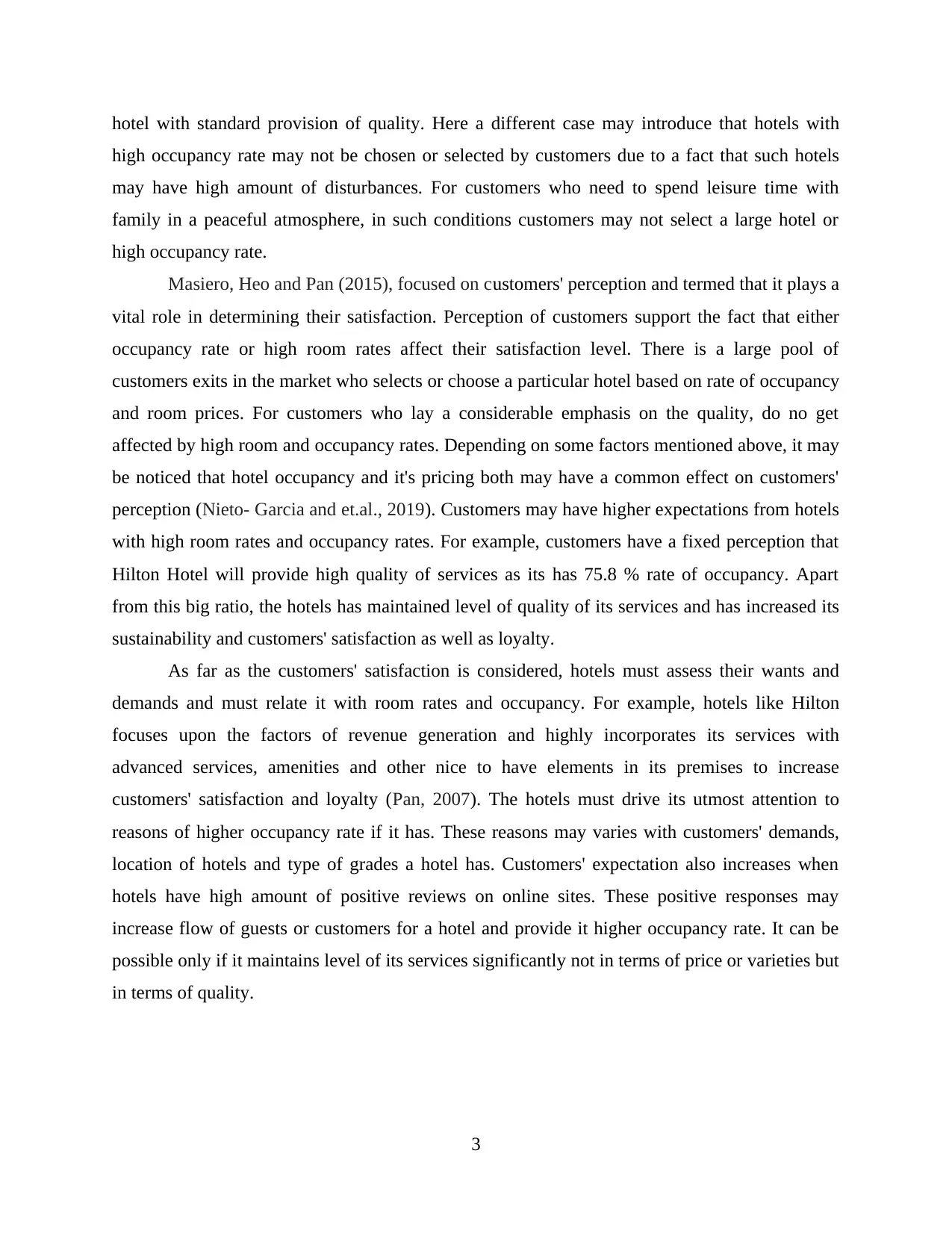
hotel with standard provision of quality. Here a different case may introduce that hotels with
high occupancy rate may not be chosen or selected by customers due to a fact that such hotels
may have high amount of disturbances. For customers who need to spend leisure time with
family in a peaceful atmosphere, in such conditions customers may not select a large hotel or
high occupancy rate.
Masiero, Heo and Pan (2015), focused on customers' perception and termed that it plays a
vital role in determining their satisfaction. Perception of customers support the fact that either
occupancy rate or high room rates affect their satisfaction level. There is a large pool of
customers exits in the market who selects or choose a particular hotel based on rate of occupancy
and room prices. For customers who lay a considerable emphasis on the quality, do no get
affected by high room and occupancy rates. Depending on some factors mentioned above, it may
be noticed that hotel occupancy and it's pricing both may have a common effect on customers'
perception (Nieto- Garcia and et.al., 2019). Customers may have higher expectations from hotels
with high room rates and occupancy rates. For example, customers have a fixed perception that
Hilton Hotel will provide high quality of services as its has 75.8 % rate of occupancy. Apart
from this big ratio, the hotels has maintained level of quality of its services and has increased its
sustainability and customers' satisfaction as well as loyalty.
As far as the customers' satisfaction is considered, hotels must assess their wants and
demands and must relate it with room rates and occupancy. For example, hotels like Hilton
focuses upon the factors of revenue generation and highly incorporates its services with
advanced services, amenities and other nice to have elements in its premises to increase
customers' satisfaction and loyalty (Pan, 2007). The hotels must drive its utmost attention to
reasons of higher occupancy rate if it has. These reasons may varies with customers' demands,
location of hotels and type of grades a hotel has. Customers' expectation also increases when
hotels have high amount of positive reviews on online sites. These positive responses may
increase flow of guests or customers for a hotel and provide it higher occupancy rate. It can be
possible only if it maintains level of its services significantly not in terms of price or varieties but
in terms of quality.
3
high occupancy rate may not be chosen or selected by customers due to a fact that such hotels
may have high amount of disturbances. For customers who need to spend leisure time with
family in a peaceful atmosphere, in such conditions customers may not select a large hotel or
high occupancy rate.
Masiero, Heo and Pan (2015), focused on customers' perception and termed that it plays a
vital role in determining their satisfaction. Perception of customers support the fact that either
occupancy rate or high room rates affect their satisfaction level. There is a large pool of
customers exits in the market who selects or choose a particular hotel based on rate of occupancy
and room prices. For customers who lay a considerable emphasis on the quality, do no get
affected by high room and occupancy rates. Depending on some factors mentioned above, it may
be noticed that hotel occupancy and it's pricing both may have a common effect on customers'
perception (Nieto- Garcia and et.al., 2019). Customers may have higher expectations from hotels
with high room rates and occupancy rates. For example, customers have a fixed perception that
Hilton Hotel will provide high quality of services as its has 75.8 % rate of occupancy. Apart
from this big ratio, the hotels has maintained level of quality of its services and has increased its
sustainability and customers' satisfaction as well as loyalty.
As far as the customers' satisfaction is considered, hotels must assess their wants and
demands and must relate it with room rates and occupancy. For example, hotels like Hilton
focuses upon the factors of revenue generation and highly incorporates its services with
advanced services, amenities and other nice to have elements in its premises to increase
customers' satisfaction and loyalty (Pan, 2007). The hotels must drive its utmost attention to
reasons of higher occupancy rate if it has. These reasons may varies with customers' demands,
location of hotels and type of grades a hotel has. Customers' expectation also increases when
hotels have high amount of positive reviews on online sites. These positive responses may
increase flow of guests or customers for a hotel and provide it higher occupancy rate. It can be
possible only if it maintains level of its services significantly not in terms of price or varieties but
in terms of quality.
3
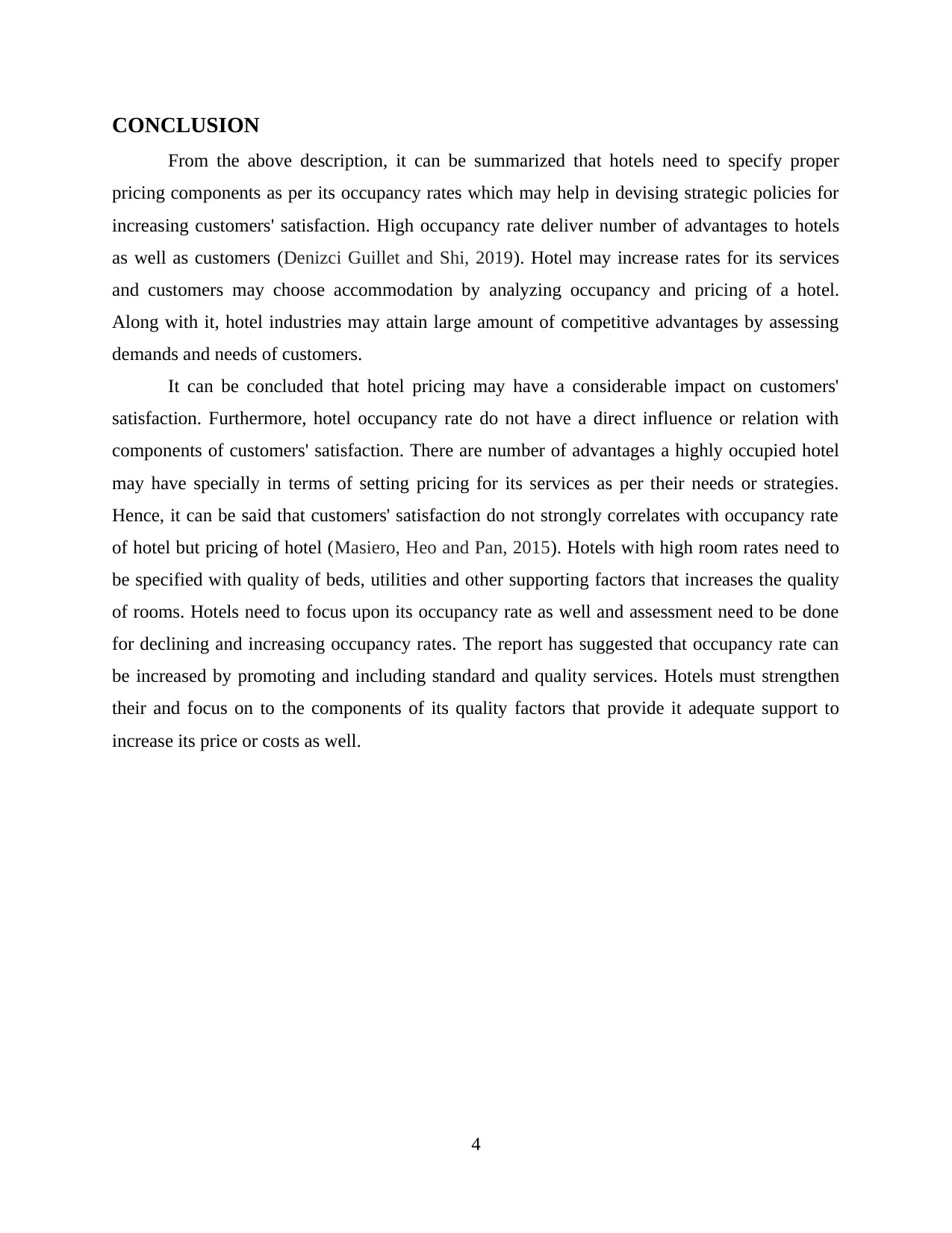
CONCLUSION
From the above description, it can be summarized that hotels need to specify proper
pricing components as per its occupancy rates which may help in devising strategic policies for
increasing customers' satisfaction. High occupancy rate deliver number of advantages to hotels
as well as customers (Denizci Guillet and Shi, 2019). Hotel may increase rates for its services
and customers may choose accommodation by analyzing occupancy and pricing of a hotel.
Along with it, hotel industries may attain large amount of competitive advantages by assessing
demands and needs of customers.
It can be concluded that hotel pricing may have a considerable impact on customers'
satisfaction. Furthermore, hotel occupancy rate do not have a direct influence or relation with
components of customers' satisfaction. There are number of advantages a highly occupied hotel
may have specially in terms of setting pricing for its services as per their needs or strategies.
Hence, it can be said that customers' satisfaction do not strongly correlates with occupancy rate
of hotel but pricing of hotel (Masiero, Heo and Pan, 2015). Hotels with high room rates need to
be specified with quality of beds, utilities and other supporting factors that increases the quality
of rooms. Hotels need to focus upon its occupancy rate as well and assessment need to be done
for declining and increasing occupancy rates. The report has suggested that occupancy rate can
be increased by promoting and including standard and quality services. Hotels must strengthen
their and focus on to the components of its quality factors that provide it adequate support to
increase its price or costs as well.
4
From the above description, it can be summarized that hotels need to specify proper
pricing components as per its occupancy rates which may help in devising strategic policies for
increasing customers' satisfaction. High occupancy rate deliver number of advantages to hotels
as well as customers (Denizci Guillet and Shi, 2019). Hotel may increase rates for its services
and customers may choose accommodation by analyzing occupancy and pricing of a hotel.
Along with it, hotel industries may attain large amount of competitive advantages by assessing
demands and needs of customers.
It can be concluded that hotel pricing may have a considerable impact on customers'
satisfaction. Furthermore, hotel occupancy rate do not have a direct influence or relation with
components of customers' satisfaction. There are number of advantages a highly occupied hotel
may have specially in terms of setting pricing for its services as per their needs or strategies.
Hence, it can be said that customers' satisfaction do not strongly correlates with occupancy rate
of hotel but pricing of hotel (Masiero, Heo and Pan, 2015). Hotels with high room rates need to
be specified with quality of beds, utilities and other supporting factors that increases the quality
of rooms. Hotels need to focus upon its occupancy rate as well and assessment need to be done
for declining and increasing occupancy rates. The report has suggested that occupancy rate can
be increased by promoting and including standard and quality services. Hotels must strengthen
their and focus on to the components of its quality factors that provide it adequate support to
increase its price or costs as well.
4
⊘ This is a preview!⊘
Do you want full access?
Subscribe today to unlock all pages.

Trusted by 1+ million students worldwide
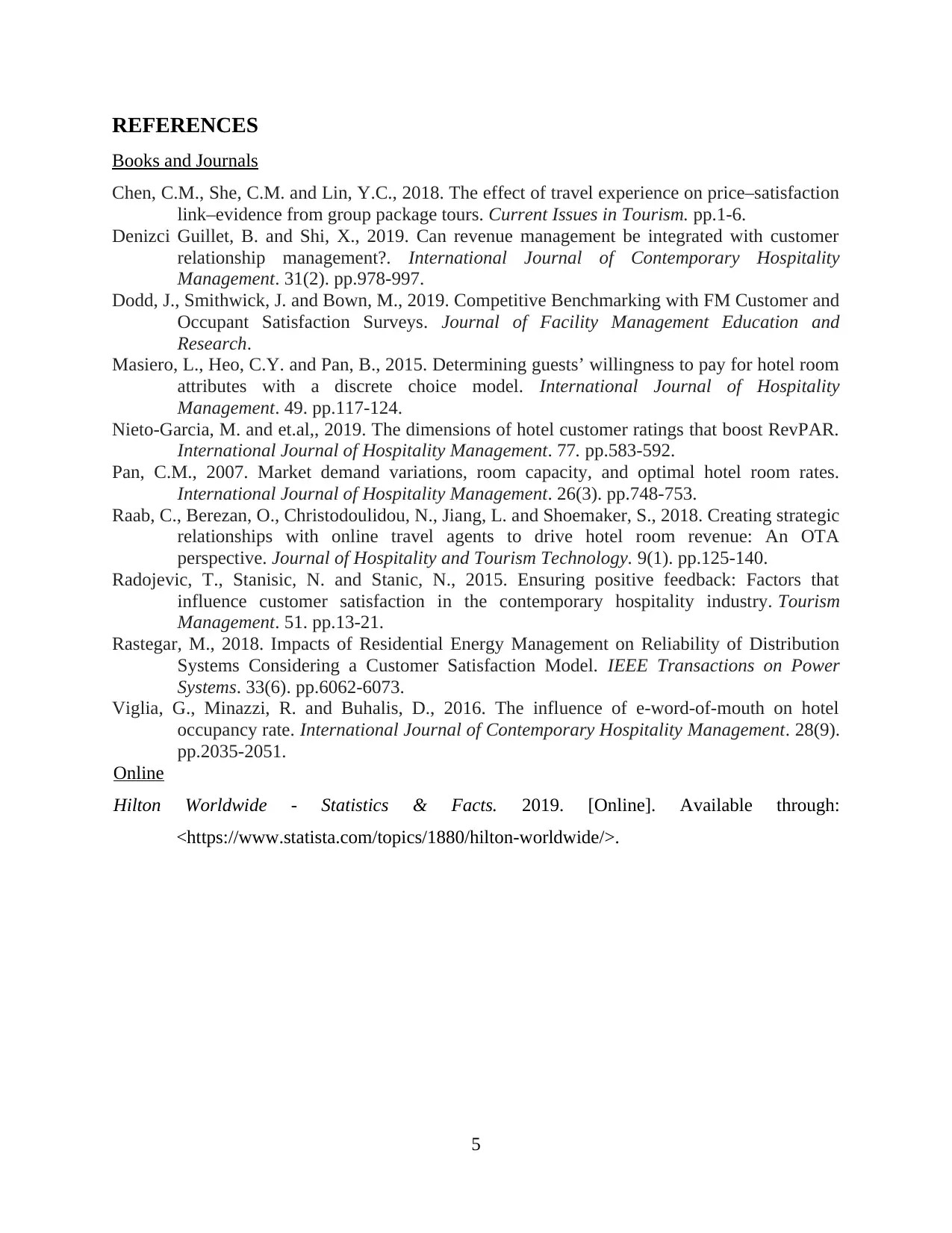
REFERENCES
Books and Journals
Chen, C.M., She, C.M. and Lin, Y.C., 2018. The effect of travel experience on price–satisfaction
link–evidence from group package tours. Current Issues in Tourism. pp.1-6.
Denizci Guillet, B. and Shi, X., 2019. Can revenue management be integrated with customer
relationship management?. International Journal of Contemporary Hospitality
Management. 31(2). pp.978-997.
Dodd, J., Smithwick, J. and Bown, M., 2019. Competitive Benchmarking with FM Customer and
Occupant Satisfaction Surveys. Journal of Facility Management Education and
Research.
Masiero, L., Heo, C.Y. and Pan, B., 2015. Determining guests’ willingness to pay for hotel room
attributes with a discrete choice model. International Journal of Hospitality
Management. 49. pp.117-124.
Nieto-Garcia, M. and et.al,, 2019. The dimensions of hotel customer ratings that boost RevPAR.
International Journal of Hospitality Management. 77. pp.583-592.
Pan, C.M., 2007. Market demand variations, room capacity, and optimal hotel room rates.
International Journal of Hospitality Management. 26(3). pp.748-753.
Raab, C., Berezan, O., Christodoulidou, N., Jiang, L. and Shoemaker, S., 2018. Creating strategic
relationships with online travel agents to drive hotel room revenue: An OTA
perspective. Journal of Hospitality and Tourism Technology. 9(1). pp.125-140.
Radojevic, T., Stanisic, N. and Stanic, N., 2015. Ensuring positive feedback: Factors that
influence customer satisfaction in the contemporary hospitality industry. Tourism
Management. 51. pp.13-21.
Rastegar, M., 2018. Impacts of Residential Energy Management on Reliability of Distribution
Systems Considering a Customer Satisfaction Model. IEEE Transactions on Power
Systems. 33(6). pp.6062-6073.
Viglia, G., Minazzi, R. and Buhalis, D., 2016. The influence of e-word-of-mouth on hotel
occupancy rate. International Journal of Contemporary Hospitality Management. 28(9).
pp.2035-2051.
Online
Hilton Worldwide - Statistics & Facts. 2019. [Online]. Available through:
<https://www.statista.com/topics/1880/hilton-worldwide/>.
5
Books and Journals
Chen, C.M., She, C.M. and Lin, Y.C., 2018. The effect of travel experience on price–satisfaction
link–evidence from group package tours. Current Issues in Tourism. pp.1-6.
Denizci Guillet, B. and Shi, X., 2019. Can revenue management be integrated with customer
relationship management?. International Journal of Contemporary Hospitality
Management. 31(2). pp.978-997.
Dodd, J., Smithwick, J. and Bown, M., 2019. Competitive Benchmarking with FM Customer and
Occupant Satisfaction Surveys. Journal of Facility Management Education and
Research.
Masiero, L., Heo, C.Y. and Pan, B., 2015. Determining guests’ willingness to pay for hotel room
attributes with a discrete choice model. International Journal of Hospitality
Management. 49. pp.117-124.
Nieto-Garcia, M. and et.al,, 2019. The dimensions of hotel customer ratings that boost RevPAR.
International Journal of Hospitality Management. 77. pp.583-592.
Pan, C.M., 2007. Market demand variations, room capacity, and optimal hotel room rates.
International Journal of Hospitality Management. 26(3). pp.748-753.
Raab, C., Berezan, O., Christodoulidou, N., Jiang, L. and Shoemaker, S., 2018. Creating strategic
relationships with online travel agents to drive hotel room revenue: An OTA
perspective. Journal of Hospitality and Tourism Technology. 9(1). pp.125-140.
Radojevic, T., Stanisic, N. and Stanic, N., 2015. Ensuring positive feedback: Factors that
influence customer satisfaction in the contemporary hospitality industry. Tourism
Management. 51. pp.13-21.
Rastegar, M., 2018. Impacts of Residential Energy Management on Reliability of Distribution
Systems Considering a Customer Satisfaction Model. IEEE Transactions on Power
Systems. 33(6). pp.6062-6073.
Viglia, G., Minazzi, R. and Buhalis, D., 2016. The influence of e-word-of-mouth on hotel
occupancy rate. International Journal of Contemporary Hospitality Management. 28(9).
pp.2035-2051.
Online
Hilton Worldwide - Statistics & Facts. 2019. [Online]. Available through:
<https://www.statista.com/topics/1880/hilton-worldwide/>.
5
1 out of 7
Related Documents
Your All-in-One AI-Powered Toolkit for Academic Success.
+13062052269
info@desklib.com
Available 24*7 on WhatsApp / Email
![[object Object]](/_next/static/media/star-bottom.7253800d.svg)
Unlock your academic potential
Copyright © 2020–2025 A2Z Services. All Rights Reserved. Developed and managed by ZUCOL.





